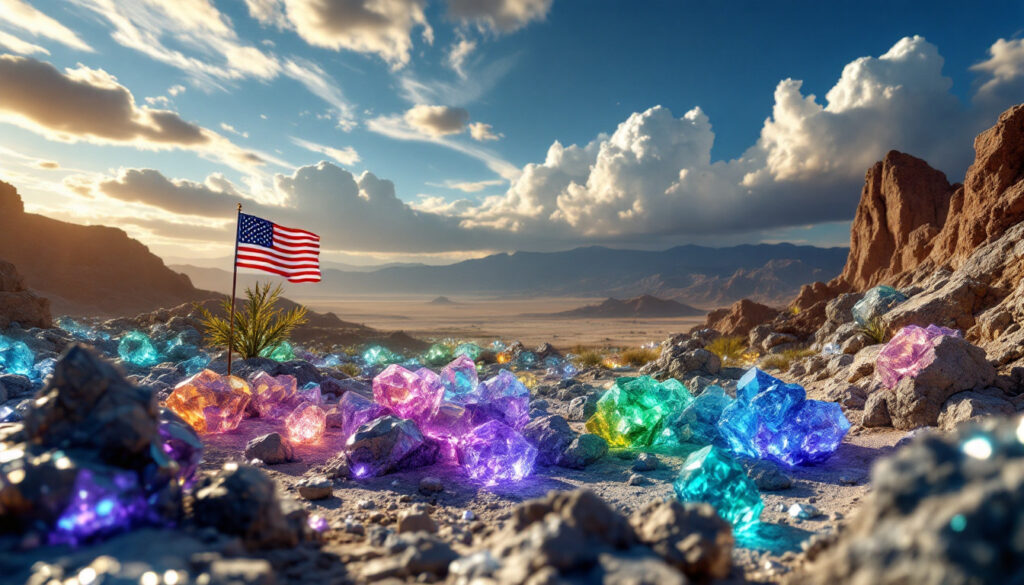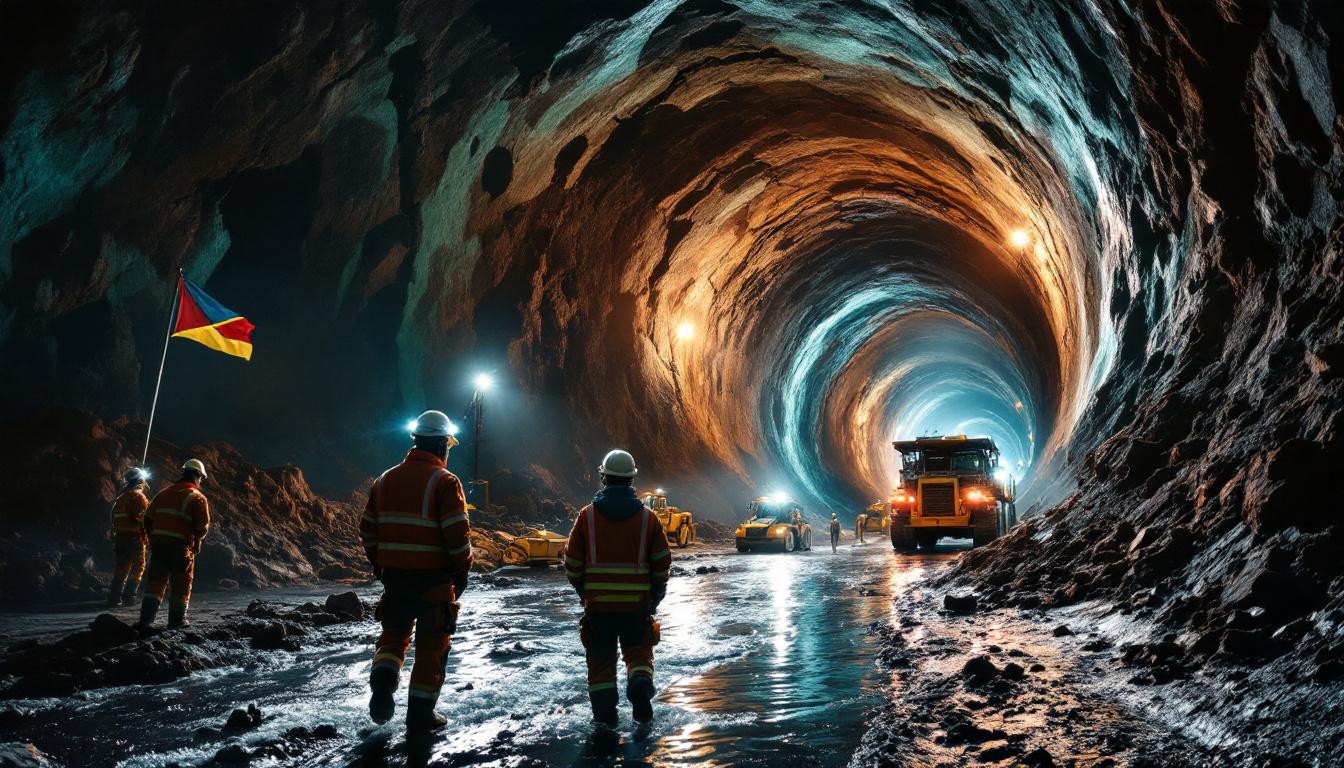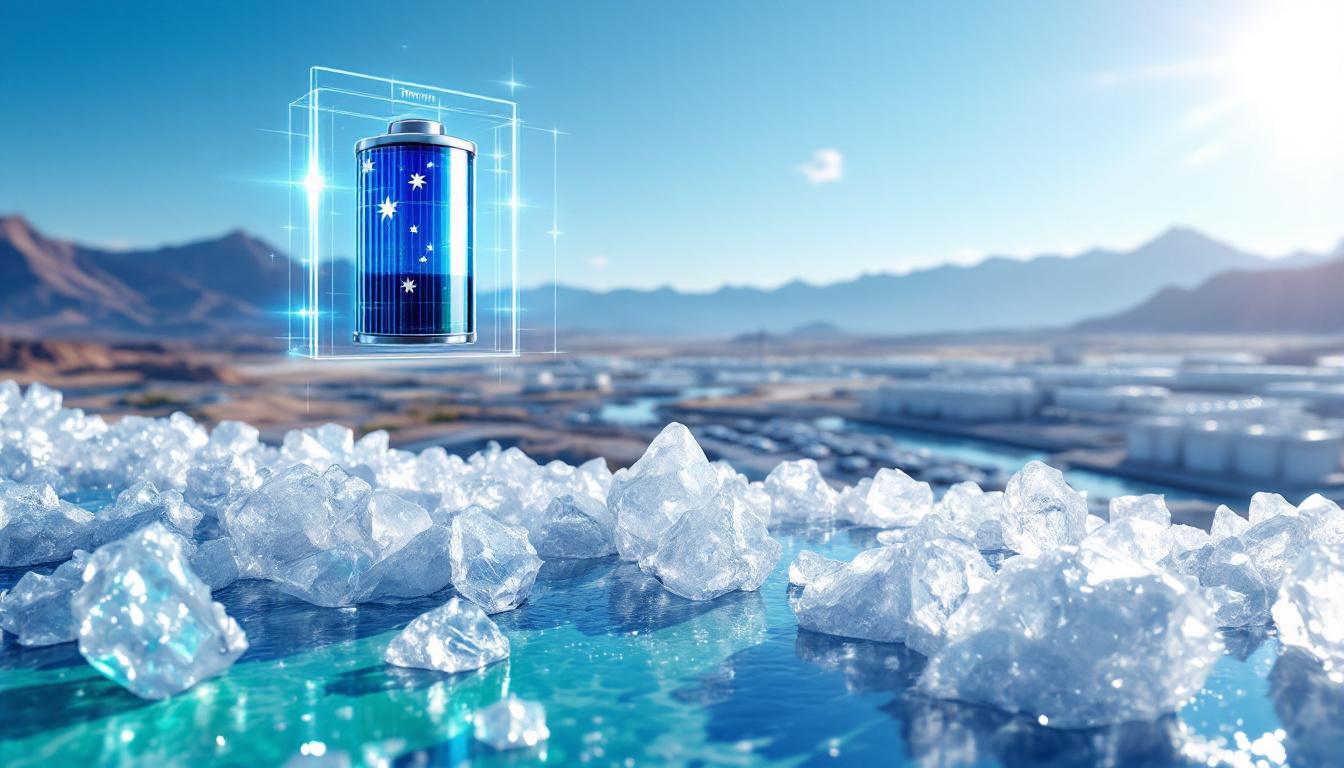What is the Mojave Antimony and Rare Earths Project? Understanding Locksley's Strategic Exploration
The Strategic Importance of the Mojave Project
The Mojave antimony and rare earths project represents a significant opportunity in the critical minerals sector, strategically located in California adjacent to MP Materials' Mountain Pass mine—the only active REE processor in the United States. This proximity gives Locksley Resources (ASX:LKY) a geographical advantage in a region that currently produces approximately 15% of global rare earth element supply, making it a potentially crucial contributor to reducing Western dependence on Chinese REE supply chains.
With China controlling approximately 70% of global REE production according to the USGS Mineral Commodity Summaries, the Mojave project takes on heightened strategic importance in diversifying supply. The global REE market is projected to grow at 10% CAGR to reach $15 billion by 2030, driven largely by critical minerals energy transition.
As Nathan Lude, Locksley Chairman, noted: "This funding puts us in a strong position to execute our exploration program and deliver key value catalysts."
Why the Mojave Project Matters in Critical Minerals Supply
Both antimony and rare earth elements found at the Mojave project are designated as critical minerals by the U.S. Department of the Interior, appearing on the official USGS Critical Minerals List of 2022. This classification highlights their essential role in national security, economic prosperity, and technological advancement.
The U.S. Inflation Reduction Act of 2022 further enhances the project's potential value by providing significant incentives for domestic critical mineral production. This legislative support aims to reduce dependency on foreign sources while accelerating the transition to clean energy technologies that rely heavily on these materials.
The project's geological setting within a carbonatite system—similar to the neighboring Mountain Pass mine—creates favorable conditions for high-grade REE mineralization, potentially offering a significant domestic source of these strategic antimony finance materials.
Critical Minerals Classification and Strategic Value
Magnet rare earth elements (particularly neodymium and praseodymium) are vital components in manufacturing permanent magnets used in electric vehicle motors and wind turbines—two rapidly growing clean energy sectors. Industry forecasts from Adamas Intelligence suggest neodymium demand alone will grow by 300% by 2030, driven primarily by EV production increases.
Meanwhile, antimony serves as a flame retardant and is used in alloy production for batteries, low-friction metals, ammunition, cable sheathing, and various industrial applications. With approximately 80% of global antimony production currently coming from China (USGS, 2024), the Mojave project represents a potential avenue for supply chain diversification in this critical material as well.
Recent Funding Developments for Mojave Exploration
How Locksley Secured $1.47 Million for Exploration
Locksley Resources recently raised $1.47 million through a heavily oversubscribed placement, issuing 36.67 million shares at 4 cents each to sophisticated and institutional investors. This strong financial backing demonstrates significant market confidence in the project's potential, with the company's share price surging 45% to 7.1 cents following the announcement.
The enthusiastic investor response suggests a growing recognition of the Mojave project's strategic importance in the critical minerals landscape. This funding achievement is notable but relatively modest compared to larger sector raises such as Hastings Technology Metals' $50 million placement in 2024, reflecting Locksley's early-stage exploration status.
Industry expert Brendan Clark, Victory Metals CEO, offered broader context on REE development in the region, stating that "North Stanmore is emerging as one of the world's most advanced heavy rare earth clay projects." This highlights the growing interest in U.S.-based rare earth developments.
Planned Allocation of Exploration Funds
The newly secured funding will directly support a comprehensive exploration campaign at the Mojave project. The exploration strategy includes:
- Drilling programs at high-priority targets
- Geological mapping and rock chip sampling
- Refinement of geophysical targets
- Additional surface sampling for geochemistry
- Structural mapping activities
- Initiation of petrological studies to inform future metallurgical testing
This methodical approach follows industry-standard exploration protocols, with geophysical targeting and rock chip sampling serving as preliminary steps before the more capital-intensive drilling phase. The company plans to employ Reverse Circulation (RC) drilling, a cost-effective method commonly used in early-stage drilling programs overview that provides reliable samples for analysis.
The exploration program remains contingent on Bureau of Land Management (BLM) approvals, which typically take 6-12 months according to BLM Handbook H-1601-1. This regulatory timeline aligns with the company's projected September 2025 drilling start date.
What Makes the Mojave Project Geologically Significant?
Exceptional Mineral Grades and Potential
The Mojave project has demonstrated remarkable mineral potential through preliminary sampling. Key findings include:
- Rock chip samples returning up to 17% antimony
- High-grade rare earth oxide results between 3.74% and 9.49% within a six-meter wide mineralized zone at the El Campo prospect
- Total rare earth oxide (TREO) measurements reaching up to 12.1% at El Campo
- Antimony mineralization reaching as high as 46% at the Desert Antimony Mine
These grades are particularly impressive when compared to industry benchmarks. Average antimony deposits typically contain 2-10% antimony according to USGS Antimony Statistics (2024), making the 46% figure from Desert Antimony Mine exceptionally high-grade. Similarly, the 12.1% TREO at El Campo compares favorably to MP Materials' Mountain Pass mine, which averages around 8% TREO, and significantly exceeds Lynas Rare Earths' Mt Weld mine in Australia with its 1.4% average TREO grade.
Geological Setting and Mineralization Characteristics
The project's geological setting contributes to its exceptional mineral potential. Located within the same geological province as the world-class Mountain Pass mine, the Mojave project benefits from similar carbonatite-hosted REE deposits that have produced some of North America's richest rare earth concentrations.
The co-location of antimony and REEs in a carbonatite system creates a unique polymetallic opportunity, as described in the USGS Carbonatite Deposits Review (2023). This geological environment typically features alkaline igneous rocks that can concentrate incompatible elements like rare earths to unusually high levels.
The presence of both antimony and rare earth elements in significant concentrations makes this a particularly valuable polymetallic prospect, potentially simplifying the economics of any future development by providing multiple revenue streams from a single operation.
Upcoming Exploration Activities and Timeline
Current Field Activities and Preparations
Locksley's exploration team is already mobilizing to the site to confirm priority targets and prepare for the upcoming drilling campaign. Current activities include:
- Confirming and pegging drill collar locations
- Establishing access routes for equipment
- Engaging with earthworks and drilling contractors
- Conducting follow-up mapping across high-priority targets
- Rock chip sampling at antimony, REE, polymetallic, and copper prospects
These preparatory activities follow standard JORC Code (2023) exploration methodologies, ensuring systematic data collection and analysis. The company's approach includes XRD/XRF analysis as part of planned petrological studies, which will provide critical mineralogical information to inform future metallurgical testing requirements.
Planned Drilling Program and Schedule
The drilling program, scheduled to commence in the September quarter of 2025, will focus on two primary targets:
- El Campo prospect: Six drill holes testing areas with TREO values up to 12.1%
- Desert Antimony Mine: Three drill holes targeting high-grade antimony mineralization up to 46%
This strategic drilling approach aims to validate the exceptional surface results and establish the subsurface extent and continuity of mineralization. The company has opted for Reverse Circulation (RC) drilling rather than diamond core, a common choice in early-stage exploration due to its cost efficiency while still providing reliable samples for analysis.
The timing aligns with expected BLM permitting timelines, which typically require 6-12 months for processing exploration permits on federal lands. This regulatory process represents a standard hurdle for mineral exploration in the western United States.
How Does the Mojave Project Compare to Other Critical Mineral Developments?
Comparison with Adjacent Mountain Pass Operations
The Mojave project's proximity to MP Materials' Mountain Pass mine provides valuable context for its potential. Mountain Pass is currently the only active REE processor in the United States, producing approximately 15% of global REE supply according to MP Materials' Q1 2025 Investor Presentation.
This established operation demonstrates the region's capacity to host world-class rare earth deposits and provides potential synergies for future development. Mountain Pass's average grade of 8% TREO establishes a benchmark against which Mojave's 12.1% TREO samples appear particularly promising.
"The Mountain Pass district has historically produced some of the highest-grade rare earth mineralization in North America, and Locksley's preliminary results suggest similar potential at Mojave." — USGS geologist (2024 Critical Minerals Assessment)
Market Position in the Critical Minerals Landscape
Within the broader critical minerals landscape, the Mojave project represents an emerging opportunity in a sector experiencing growing demand. Antimony prices have reportedly reached $60,000 per tonne recently according to USGS Mineral Commodity Summaries (May 2025), while rare earth elements—particularly those used in permanent magnets—continue to command premium prices.
The global context is significant: China controls approximately 80% of global antimony production (USGS, 2024) and 70% of rare earth elements, creating supply vulnerabilities that the Mojave project could help address. The Global Rare Earth ETF (REMX) has demonstrated this sector's growth potential, up 20% year-to-date according to VanEck (May 2025).
Demand drivers appear robust, with neodymium requirements projected to grow 300% by 2030 according to Adamas Intelligence (2024), primarily due to electric vehicle production increases and renewable energy expansion.
What Are the Regulatory and Environmental Considerations?
Permitting Process and Current Status
The exploration program at Mojave is proceeding through the necessary regulatory channels, with Locksley currently awaiting Bureau of Land Management approvals before drilling can commence. This regulatory process is a standard requirement for mineral exploration on federal lands in the United States and represents a critical step in advancing the project.
The BLM approval process typically requires 6-12 months, involving environmental assessments and public comment periods. This timeline aligns with Locksley's projected September 2025 start date for drilling activities.
Environmental and Sustainability Factors
As with any mining project, environmental considerations will play a significant role in the Mojave project's development. The exploration program will need to adhere to strict environmental standards, particularly given California's robust regulatory framework under the California Environmental Quality Act (CEQA).
Future development plans will likely incorporate sustainable mining practices and responsible resource management strategies. The nearby Mountain Pass operation has demonstrated the feasibility of operating a rare earth mine in California while meeting stringent environmental requirements.
Potential sustainability initiatives could include renewable energy integration similar to Tesla's Nevada Gigafactory solar implementation, addressing the energy-intensive nature of mineral processing while reducing the operation's carbon footprint.
What Does This Mean for Investors and the Critical Minerals Market?
Investment Implications and Market Response
The market's strong response to Locksley's capital raising—with shares jumping 45% on the announcement—indicates significant investor interest in the Mojave project. This enthusiasm reflects growing recognition of critical minerals' strategic importance and the potential value of developing domestic supply chains for these essential resources.
However, investors should note several risk factors:
- Price volatility: Antimony has historically experienced ±30% annual price swings according to Trading Economics (2024)
- Regulatory timelines: Mining permits in California can face delays and uncertainty
- Technical challenges: Metallurgical recovery rates for rare earths can significantly impact project economics
- Development timeline: Typical mining projects require 5-10 years from exploration to production (CRU Group, 2023)
Despite these challenges, the sector's performance remains strong, with the VanEck Rare Earth ETF (REMX) up 20% year-to-date, suggesting continued investor confidence in critical minerals.
Long-term Strategic Value and Market Positioning
The Mojave project's focus on both antimony and rare earth elements positions it advantageously in the critical minerals market. As global demand for these materials continues to grow, driven by clean energy transitions and technological advancement, projects like Mojave that can potentially contribute to secure, domestic supply chains may command premium valuations.
The project benefits from several strategic advantages:
- Dual commodity exposure: Both antimony and rare earths provide diversified market potential
- Domestic location: U.S.-based projects benefit from Inflation Reduction Act incentives
- Exceptional grades: Preliminary samples exceed industry averages
- Established mining district: Proximity to Mountain Pass demonstrates geological potential
These factors collectively suggest a potentially compelling long-term value proposition, though investors should recognize the early-stage nature of the project and associated exploration risks.
FAQs About the Mojave Antimony and Rare Earths Project
What makes rare earth elements "critical minerals"?
Rare earth elements are classified as critical minerals due to their essential role in advanced technologies, limited substitutability, and concentrated global supply chains. According to the U.S. Energy Act of 2020, critical minerals are defined by:
- Economic vulnerability if supply is disrupted
- High importance to energy, defense, and manufacturing sectors
- Significant supply chain risk due to foreign dependency
They are vital components in permanent magnets used in electric vehicles, wind turbines, and defense applications, making them strategically important for economic and national security.
How does antimony factor into the project's value proposition?
Antimony adds significant value to the Mojave project as a separate critical mineral with diverse applications. Used as a flame retardant and in various alloys, antimony has experienced strong price performance, reportedly reaching $60,000 per tonne according to USGS Mineral Commodity Summaries (May 2025).
The presence of high-grade antimony (up to 46%) alongside rare earth elements creates a valuable polymetallic opportunity. This dual-commodity approach potentially enhances project economics by providing multiple revenue streams while sharing infrastructure and processing costs.
Additionally, with China controlling approximately 80% of global antimony production, domestic sources represent strategic diversification for U.S. supply chains in batteries, electronics, and defense applications.
What timeline can investors expect for project development?
The current exploration phase, including drilling scheduled for the September quarter of 2025, represents an early stage in the project's development. Following successful exploration, the project would likely progress through resource definition, economic studies, permitting, and potentially development phases—a multi-year process typical for mining projects.
According to CRU Group (2023), the typical mining development cycle spans 5-10 years from exploration to production. Key milestones would include:
- Exploration drilling: 1-2 years (currently planned)
- Resource definition: 1-2 years
- Preliminary economic assessment: 6-12 months
- Permitting and environmental studies: 2-4 years (potentially longer in California)
- Construction decision and financing: 6-12 months
- Mine construction: 1-3 years
This extended timeline requires patient capital and represents a long-term investment proposition rather than a near-term production opportunity.
How might geopolitical factors influence the project's importance?
Growing concerns about supply chain security, particularly for critical minerals dominated by Chinese production and processing, enhance the strategic value of Western projects like Mojave. U.S. government initiatives to secure domestic critical mineral supplies could potentially provide supportive policy frameworks and funding opportunities for projects like this one.
Key geopolitical factors include:
- Trade tensions: Ongoing U.S.-China trade disputes could impact REE and antimony imports
- Policy support: The Inflation Reduction Act provides incentives for domestic critical mineral production
- Defense applications: Both antimony and REEs have military applications, elevating national security interest
- Energy transition mandates: Government clean energy targets drive demand for REE-containing technologies
These geopolitical considerations may provide tailwinds for domestic projects, potentially accelerating permitting timelines or unlocking government support for mineral deposit tiers guide and 3D geological modelling in the exploration in the Mojave antimony and rare earths project.
Disclaimer: This article contains forward-looking statements about mineral exploration and market developments. Mineral exploration is inherently uncertain, and actual results may differ materially from expectations. Investors should conduct their own due diligence before making investment decisions. Market conditions for critical minerals are subject to rapid changes due to technological, regulatory, and geopolitical factors.
Want to Capitalise on the Next Major Mineral Discovery?
Discover why ASX mining announcements like Locksley's Mojave project can lead to significant investment returns by exploring Discovery Alert's dedicated discoveries page. Get real-time notifications on promising mineral discoveries powered by the proprietary Discovery IQ model at https://discoveryalert.com.au/discoveries/ and position yourself ahead of the market with a 30-day free trial.




